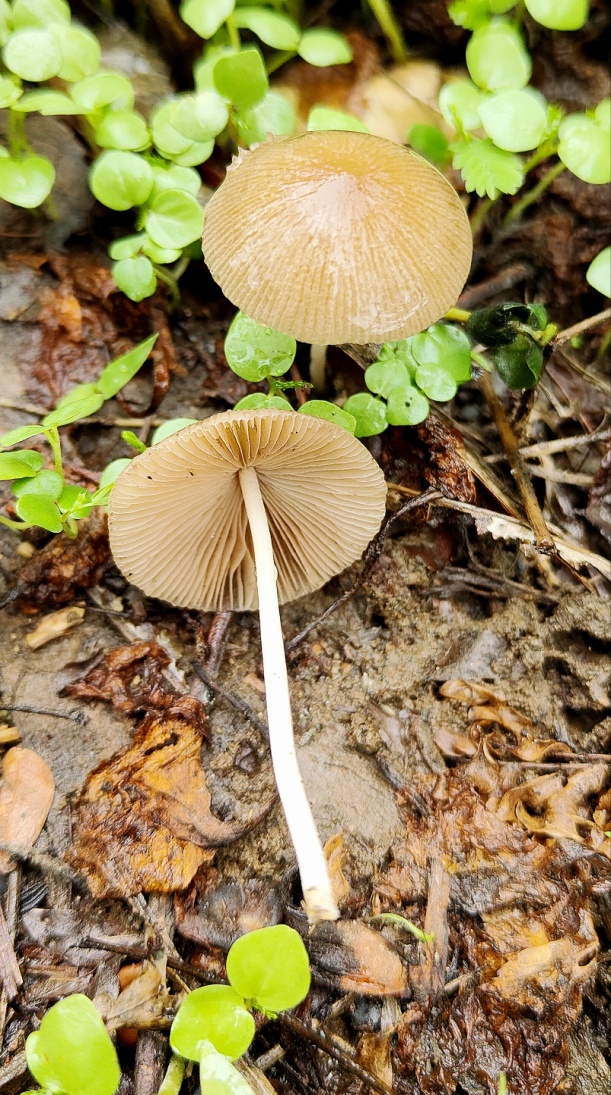Fruiting body small to medium. Pileus 1-4 cm, conical at first, hemispherical or hemispherical-convex, later campanulate-convex to campanulate-applanate, pubescent to glabrous, glutinous when wet, light ochraceous, brown to yellowish brown, pale brown towards margin, hygrophanous; Lamellae narrowly adnate to almost free, crowded, ventricose, pale yellowish to yellow-brown to rusty brown. Stipe 3-7.5 × 0.2-0.3 cm, narrow upwards slightly broadening towards base, hollow, pale white to yellowish tinge. Taste and odour indistinct. Spore-print rusty brown. Basidiospores 9.8-12×5.8-7μm; narrowly-ovate, ovate-ellipsoid to ellipsoid, in side view ellipsoid, with distinct germ-pore, thick-walled, pale honey-brown. Basidia 24.4-33.8×9-12μm, clavate, 4-spored. Cheilocystidia 18.2-28.8×8.5-10.5μm, lecythiform. Pleurocystidia absent. Pileocystidia hair like, 70.0×2.0μm, scattered. Pileipellis hymeniform, consisting of sphaero-pedunculate and pyriform cells 15-30 μm wide. Clamp connections not observed.
Specimens examined
India, Maharashtra, Kolhapur, Karvir, Kolhapur-Amba road, (16°52ʹ53ʺN-74°01ʹ24ʺE) in a group, amongst Maize corn debris, 19.06.2020, Bornak, S. I. and Patil, A. R. (Y20V2C6); Rajaram College campus (16°41ʹ09ʺN-74°15ʹ23ʺE), amongst decaying litter, solitary, scattered, 09.07.2023, Bornak, S. I. and Patil, Y.S. (Y23V1C1).
Remarks
The present species matches with description of Prydiuk (2014). Large carpophores, a pale grey, hood-shaped, conical pileus with a radially ridged surface, and big spores are characteristics of Conocybe apala (Amandeep, et al., 2015). C. apala closely resembles C. albipes, but The lack of pseudo-paraphyses and the thinner spores distinguish C. apala. C. inocybeoides Watling, which has similarly large basidiocarps but differs by a brighter pileus, basidia with 2 sterigmata, as well as larger and broader spores (Prydiuk, 2014).
The saprobic mushroom C. apala grows alone or occasionally in small groups in places with rich soil and short grass, such as lawns, meadows, and pastures, as well as in decomposing manured straw. It is a fungus that is frequently reported in both North America and Europe (Amandeep, et al., 2015). Indian records of this fungi are from Punjab (Amandeep, et al., 2015). This is the first record from Maharashtra state.
References:
Prydiuk, M.P. (2014). Some rare and interesting Conocybe found in Vyzhnytsia National Nature Park (Ukrainian Carpathians). Mycobiota 4: 1–24. doi: 10.12664/mycobiota.2014.04.01
Amandeep, K., Atri, N.S. and Munruchi, K. (2015). Diversity of species of the genus Conocybe (Bolbitiaceae, Agaricales) collected on dung from Punjab, India. Mycosphere, 6(1), 19–42, Doi 10.5943/mycosphere/6/1/4





